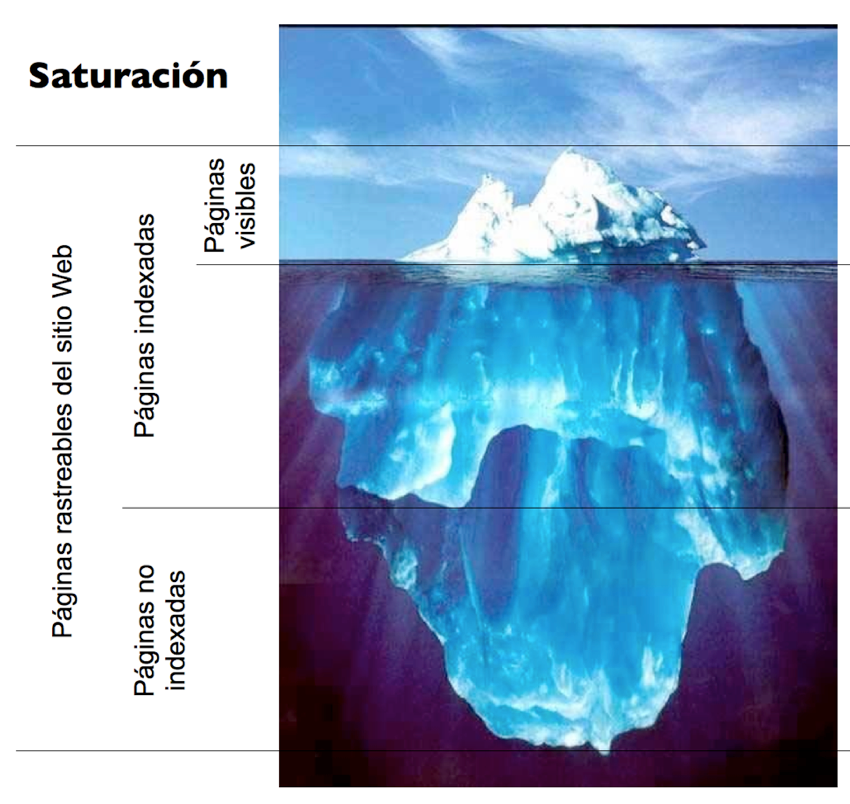Written by Fernando Maciá
Index
A higher number of indexed pages is not always synonymous with more traffic. In general, though, a domain with more content is more likely to appear for a wider variety of searches, focus on positioning on those searches that are most popular and generate the highest quality traffic can help us concentrate our efforts on the group of pages or content that are most profitable.
Saturation, indexability objective
One of the objectives of indexability is to ensure that as many pages of a Web site are indexed by search engines as possible. The relationship that exists between the number of indexable pages -content pages open to indexing, linked together, included in archives sitemap and not blocked by the robots.txt file or the meta robots on the page itself- and the number of indexed pages -crawled by the search engines and added to their indexes- is called saturation.
The objective of indexability is that the saturation of a Web site tends to 100 percent, i.e. that all available pages are effectively indexed.
In general, we presume that the greater the number of indexed pages on a Web site, the greater the chances that some of those pages will rank well for related searches and generate organic traffic. It is often taken as a rule that the bigger a site is, the more traffic it will get.
Indexable pages and indexed pages
Knowing the total number of indexed pages of a reasonably large Web site is not easy. First of all, the constant generation of content makes it impossible to know exactly the total number of indexable pages at any given time. To do this, we would have to generate a comprehensive and up-to-date sitemap file. By adding this sitemap to Google Webmaster Tools, Google would indicate the total number of URLs indexed with respect to the maximum number of URLs contained in the sitemap file.
Determining the exact total number of crawlable pages on a dynamic Web site is often not an easy task, due to the constant updating of content.
This indicator, however, is not entirely accurate either. Google can keep in its index a higher number of indexed URLs of the Web site than those contained in the sitemap file. We can check it using the command site:domain.ext in Google. In many cases, the total number of results returned by the search engine will be considerably higher than the number of URLs included in the sitemap file.
This is because Google includes URLs that may have already been unsubscribed (they will not disappear from the index unless they are redirected or return a 404 error), a certain amount of duplicate content (URLs with sort parameters, with session IDs, paginations…) etc.
Positioned pages: the only visible pages

A much more accurate KPI to look for a correlation between content and visibility is the number of unique URLs that effectively functioned as landingpagesfor organic traffic. That is, these are the distinct pages that received at least one direct visit from an organic search engine result. If we compare this number to the number of total pages on the site we will see that it is a much smaller percentage – perhaps 10 to 40 percent – of the total number of total indexed pages. Either in comparison with the number of URLs indexed among those contained in our sitemap file, or in comparison with the number of search results with the command site:domain.ext.
Since we have empirically proven that it is very difficult for the total number of indexed pages to rank effectively, our objective will therefore be to focus on the pages that rank the best and attract the most and the best traffic.
Given that sometimes a page may receive a visit from a non-relevant search, sometimes a minimum threshold is set to genuinely consider that a page has effectively functioned as an organic traffic landing page. It is thus established that to enter this category a page must receive a minimum number of visits. This threshold will be established based on the total website traffic.
Most profitable Web site pages
These pages should therefore coincide with our most profitable pages. If we manage to concentrate the best positioning on the pages that generate the highest ROI, we will be maximizing the performance of the Web site.
Most profitable e-commerce pages
In an e-commerce Web site, our most profitable pages will be the ones with the highest number of page views, the highest conversion rate and the highest profit margin sales items. Find out how to focus website authority on the most profitable pages by reading our post on SEO and information architecture in online stores.
More profitable pages in a content portal.
In a content Web site, the most profitable pages will be those that generate the most page views (banner impressions, advertising) at the lowest cost of generating that content.
Most profitable pages in a lead generation portal
In a Web site focused on lead generation, the most profitable pages will be those that achieve the highest conversion rate in the form of lead registration.
In order to place the most profitable pages in the best positioned nodes of information architecture, we must have a content manager that allows flexible and customized management of taxonomies and folksonomies.
This management can be focused on adapting, for example, the products highlighted in the home page or in each content section with those that generate the most demand based on seasonal search patterns, by target audience profile, by target country for each version of the Web site, etc.
Seasonal search patterns
It is common for demand for certain products to coincide or occur at the same time each year. We say that these searches have a seasonal behavior. To confirm this pattern, we should note that the same pattern has been reproduced in a similar way in recent years with tools such as Google Trends. Web analytics could also provide clues to seasonal search patterns.
If our Web site has seasonal search patterns, we should identify which are the most frequent searches at each time of the year and tune the featured products on the home page according to those searches. This will ensure that the most profitable pages are the best positioned at all times.
Most demanded products by target audience profile
If we have a Web site organized around defined target audience profiles -For example, “customers”, “registered users”, “large accounts” or “individuals” – our recommendation is to have Web analytics profiles that allow us to filter the specific behavior of each of these user profiles, to the extent that we can configure and measure it, in order to identify what their preferences are.
Once the profile corresponding to a visitor has been selected, or identified if we do so by means of a cookie in his browser, we will be able to personalize the product offer of our home page to adapt to the expectations that we can anticipate from his history as a customer.
Amazon, for example, customizes its home page in this way to show us as suggested and featured products those that best match our previous browsing and purchase history on the Web site.
Most demanded products by target country of the Web site version
When our Web site has different language versions oriented to different countriesIn addition, it is advisable to have a personalized management of the product portfolio that allows us not only to specify the product references available in each country, but also to manage which of these references appear as featured products in the home page or in shortcut sections such as “best sellers”, “most demanded”, etc.
Having different profiles with which to filter the behavior of traffic from each country will allow us to identify the preferences of users in each of the versions of our Web, which will allow us to better adapt to their tastes.
Once these preferences have been identified, we will be able to adapt our offer much better to the specific demand of each country and we will be able to better tune in to it. In this way, we will be able to highlight those products that respond to the preferences of buyers in each country, even in accordance with the seasonal pattern cycle of that country.



